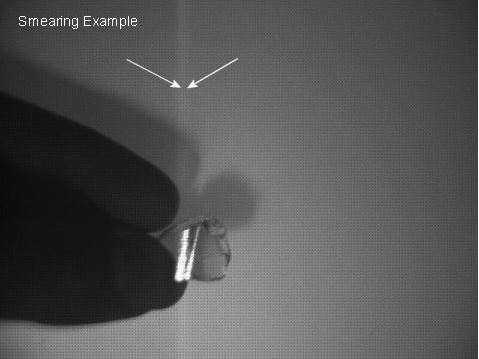Vertical bleeding or smearing from a saturated portion of an image
Last Revision Date: 6/29/2015
It is sometimes possible to see a faint bright line that extends from the bottom of the image to the top of the image, passing through a light-saturated spot. This article describes this effect, called smear, and how to avoid it.
In the sample image below, a faint bright line can be seen that extends from the bottom to the top of the image, passing through the light saturated spot.

This bleeding effect is called "smearing," and is an undesired signal that appears as a brighter vertical (from top to bottom) stripe emanating from a bright part of the image. Smearing is a common problem in high light intensity settings.
Smear Explained
On the interline transfer CCDs used in many cameras, each pixel consists of a light sensitive area, called the photosensor, and a light-shielded area, called the vertical transfer register. The vertical transfer register is used to shift the charge out of the photosensor and off of the sensor. Although vertical transfer cells are approximately 100,000 times less sensitive than the light sensitive region, photons may still tunnel into this area, especially when exposed to very bright light. This tunneling, or leaking, is the source of smear.
During image readout, image pixels are shifted vertically downard, row by row, through the vertical transfer cells to the readout register. If there is any leakage of charge into an area of the vertical transfer register, it will be picked up and shifted downward, so that every pixel above and below the area will contain this extra charge. The result is a relatively bright vertical stripe across the entire image.
Effect of Integration Time and Lens Aperture on Smear
Smear is often more noticeable when using very short (microsecond) shutter times. This is because the amount of charge collected in the light-sensitive area of the CCD varies based on exposure time, whereas the amount of
Smear may be addressed
-
- Increase shutter (integration) time. This will increase the amount of time light is collected in the photosensors relative to the time in the vertical transfer register.
- Turn the light source off before and after an exposure by using a mechanical or LCD shutter.
- Use a pulsed or flashed light source. A pulsed light of 1/10,000 duration is sufficient in most cases to allow an extremely short 100ns exposure without smear effect.
- Increase light collimation by using a lens with variable aperture and stopping it down (closing the aperture), or using a lens with a smaller aperture. Note that an effect of closing the iris will be darker images.
- Some cameras have specific mechanisms for reducing smear. For more information, consult your camera's Technical Reference manual.